The best gaming monitor is a must for gamers. ASUS ROG Swift 360Hz PG259QN is a 1080P Full HD, Fast IPS, 1ms, G-SYNC, ULMB, Eye Care gaming monitor. This monitor is discussed in detail in the Asus ROG Swift 360Hz PG259QNR Review, which will give you an obvious idea about this monitor.
They are finally here! The fastest 360Hz monitors ever hit the market for eSports gamers who want to get the most out of the next generation of graphics cards. The Asus ROG Swift, 360 Hz PG259QNR, will be the first model that we will analyze. With total certainty, it will be a reference in this segment because it is full of news with Nvidia Reflex Latency Analyzer and Nvidia G-Sync technology.
But it’s not just pure gaming performance; it’s image quality and design. Featuring a well-calibrated 10-bit IPS panel and achieved high color coverage and HDR support, and exceptional ergonomics on a new aluminum base. Stay with us to see this gaming beast in action. Let us begin!
And before continuing, we thank Asus for trusting us by giving us this monitor for analysis.
Table of Contents
Asus ROG Swift 360Hz PG259QNR technical characteristics
24.5” HDR Gaming Monitor, 1080P Full HD, Fast IPS, 1ms, G-SYNC, ULMB, NVIDIA Reflex Latency Analyzer, HDMI DisplayPort USB, Desk Mount Kit, VESA Wall Mountable, HDR10
Among its main features, We find
- Display Type: LED
- Screen Size: 25 inches
- Aspect ratio: 16:9
- Brightness: 400 nits
- Resolution: FHD 1080p
- Refresh Rate: 360Hz
- Response Time: 1ms
- Weight: 15.65 lbs
- Color: Black
- Dimensions: 21.93 x 14.92 x 9.72 inches
- Contrast Ratio : 1000:1
Unboxing
Since its introduction, the Asus ROG Swift 360 Hz PG259QNR presents a new packaging concept that is undoubtedly the best we have seen in a monitor to date. On the outside, it will look the usual way on an Asus ROG product, with photos of the product on vinyl style printing and full of references to its characteristics.
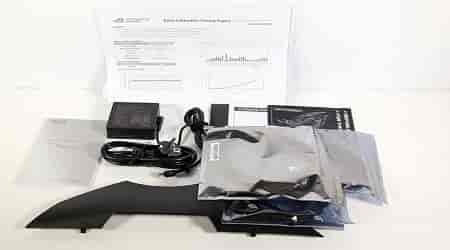
The best is inside, especially for those of us who unpack a lot of boxes at the end of the day. And it is that as a fixing mold, high-density polyethylene foam has been used, which protects much better than white cork. In addition, we can easily extract the sandwich mold by pulling it from a central grip. We found the monitor and base protected with bags and the accessories inside a cardboard box.
The bundle will have the following elements:
- Monitor Asus ROG Swift 360Hz PG259QNR
- Desk stand
- Support for table fixing
- Rear panel port cover
- Calibration report
- DisplayPort cable
- HDMI cable
- 90W power adapter with a European plug
- USB 3.2 Gen1 Type-B to Type-A Cable
- User manual
- Warranty card
- ROG stickers various
Undoubtedly a huge number of elements will allow the user to get the most out of this monitor regarding its placement and connection.
Exterior design and two ways of laying
The Asus ROG series is distinguished mainly by the aggressive design of its base and support, now with technical improvements that make it more resistant and stable. Unlike the ROG Strix models, this Asus ROG Swift 360Hz PG259QNR does not have a lighting projection on the stand. The secondary color becomes gold instead of red, always on a matte light gray.
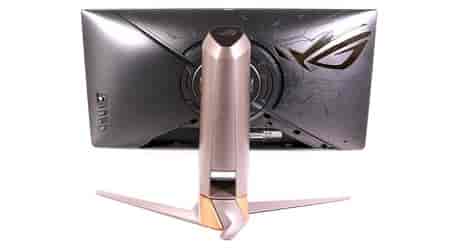
The monitor will come practically wholly assembled, and we only have to fix the support to the legs, which process we will only do by fitting the two pieces together and tightening the two thumbscrews at the bottom. In this way, we would have the monitor ready for placement, and it will require a lot of space with almost 25 cm of depth.
But if we are more limited in space or have a desk with little depth, this time-fixed support for the table has been included. This is as thick and consistent as the legs but will be attached to the table’s edge with a steel clamp. It provides very good stability and rigidity, with the advantage of gaining frontal space. But we must be careful with how much we press because we could sink the table with too much pressure, and if we press too little, the monitor could fall after a while.
We leave the design behind the base and go a little higher to the support, which consists of an aluminum arm of considerable weight and thickness with a hydraulic mechanism for vertical movement. The screen of the Asus ROG Swift, 360 Hz PG259QNR, will be taken with another mechanism of wide ergonomics and rigid enough to almost eliminate sway. As always, we will have a hole to route the monitor cables and the possibility of screen rotation.
The rear cone of the screen is incredibly worked to give us an aggressive aesthetic with the screen printing in the purest ROG style. The well-worked screen rotation mechanism is joined by a huge Asus logo equipped with Asus AURA Sync lighting compatible with Armory Crate. The port location remains in the usual position, looking down into a fairly deep hole and not too accessible. The monitor will be compatible with 100 × 100 mm VESA mounts.
Located already in the front area, the optimization work that has been done on the monitor frames is very good. Except for the lower area, the rest of the frames are directly integrated into the screen, having only the minimum edge of the plastic encapsulation where the screen is glued. The sides’ thickness and the top are 7 mm, and the bottom 16 mm, quite tight even for a desktop monitor. This will come in handy for multiscreen setups, although prepare your pocketbook because cheap is not going to be the game.
Complete ergonomics
The ergonomics of this Asus ROG Swift, 360 Hz PG259QNR, are at the high level that we could expect since, with a 25-inch eSport-oriented product, we must have the maximum possible versatility.
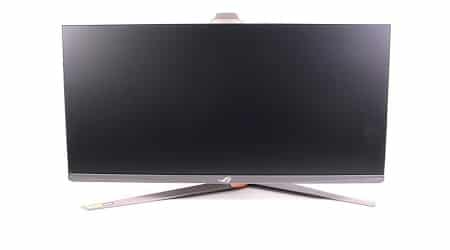
The height adjustment will be produced by the arm provided with a hydraulic mechanism, supporting a range of about 120 mm. We will start from the lowest position of the screen at about 60 mm from the ground in the lower part, and we will reach a height of 510 mm measured at the upper edge. A very wide range to adapt it perfectly to any table and chair.
The next unlocked axis will be the vertical orientation or screen rotation, which occurs with the rotation mechanism at the support and base junction. It will allow an angle of 25 or both left and right. If we want to tilt the screen, we can also, supporting an angle of 20 or up and -5 or down. Finally, it will be possible to pivot the screen only in a clockwise direction at 90 o to put it in reading mode.
Varied ports, with more importance of USB
This time the USB ports of the Asus ROG Swift 360 Hz PG259QNR take more prominence, as one of them will be the one we use for the new Nvidia Reflex Latency technology. We have the following:
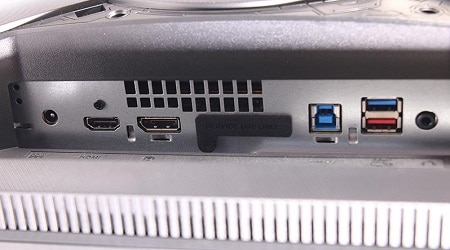
- Jack for DC power
- 1x HDMI 2.0
- 1x DisplayPort 1.4
- USB 3.2 Gen1 Type-B
- 2x USB 3.2 Gen1 Type-A
- 3.5mm audio jack
- Kensington slot for universal locks (back)
Precisely the USB with the red border will be the one that we must use to measure the system’s latency by joining the compatible elements. In any case, both function as uploading and downloading of data from flash drives or for connection of other peripherals.
Although we do not have speakers, there will be a Jack output to output the audio that travels through the video ports. Of these, the one we must use to get the most out of the monitor will be the DisplayPort since the HDMI only supports maximum frequencies of 240 Hz.
Screen and features for eSports
A monitor like this Asus ROG Swift 360Hz PG259QNR is purely designed for competitive gaming and users who practically live from it. A sporadic gamer user will not take full advantage of its technology and speed, although if you have a budget to spare, then go ahead. But pay close attention to the excellent color performance of the panel because a lot of work has also been done on it.
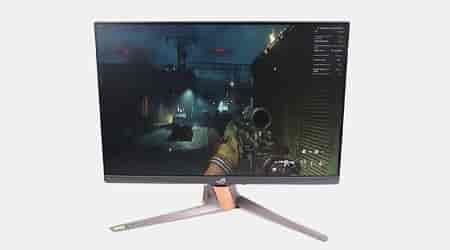
Its basic characteristics are an IPS LCD technology panel, the fastest built by supporting a maximum refresh rate of 360 Hz. In this case, we have a compact size of 24.5 inches and a Full HD native resolution at 1920x1080p in 16: 9 image format. It offers us a contrast of 1000: 1, peak brightness of 400 nits with support for HDR, and 10 bits of color depth.
This high refresh rate uses a chip with Nvidia G-Sync technology for a dynamic refresh, which we can activate from the control panel of our green brand card. The response speed will be 1 ms, with Flicker-free and Anti-glare technology to give us the best possible image experience. From the OSD, we can choose between three OverDrive modes to adjust the panel’s performance and eliminate possible ghosting. Similarly, it has a black equalizer to overexpose very dark areas of the game.
Other common functions in Asus monitors like this will be GamePlus, which gives us options for an FPS counter, stopwatch, custom crosshairs, or multi-monitor alignment. Or GameVisual, with multiple gaming-oriented image modes with one especially important such as G-Sync Esports, which we must use when we activate the star technology Nvidia Reflex Latency Analyzer. It also has Asus’ ULMB (Ultra Low Motion Blur) technology but must use this with G-Sync and a maximum refresh rate of 144 Hz.
ULMB is a useful technology for lower frequencies, and in this case, we will already have this need covered with 360 Hz. It may be interesting for those who want to adjust the monitor’s refresh rate to the game’s FPS if these figures are around 144 Hz to improve performance will otherwise remain disabled.
A huge range of functions and technology, but the quality of the panel of this Asus ROG Swift 360 Hz PG259QNR is not far behind with its 10-bit depth. And we have practically 100% sRGBin color coverage and a very good calibration, as we will see. Its viewing angles of 178 or meet the requirements and the absence of bleeding at the corners, blurring or ghosting at the least in this unit we reviewed. As almost always, it is certified Low Blue Light with TÜV Rheinlandwith four filter settings.
Color Testing and Calibration in Asus ROG Swift 360Hz PG259QNR Review
We now turn to see the calibration of this Asus ROG Swift 360 Hz PG259QNR and its actual image characteristics. We will use the ColorMunki Display colorimeter in combination with the DisplayCAL and HCFR programs in search of color results. Being a gaming monitor, we will check how ghosting is on it.
Ghosting and other image artifacts
We will carry out the tests using the testudo page and its ghosting test. We will capture a moving image with the camera at the same speed as the ufo in each test, always at a 360 Hz refresh rate. We will compare this with two reference images where we would see how ghosting occurs.
We have a very slight black trail with the OverDrive configuration disabled in the first image, insufficient to say that these are ghosting. But activating the OD option in normal shows that this trail is completely reduced in the second image. Finally, with the extreme OD option, we are presented with a negative trail, so it is not an option that for 360 Hz goes well.
Therefore, we can say that the best option will be the normal one, where the image is perfect. If we recall the Asus ROG Strix XG438Q 240Hz review, today’s model further improves movement and image clarity. The moving camera we use tends to put a lot of blur in the image, and in this case, we can even see a fairly clear image, which, when translated into reality, our eyes see it sharp even at higher speeds. We can say that the jump from 240 to 360 Hz is noticeable, especially in response and sharpness in fast movements.
Brightness and Contrast
This part of the Asus ROG Swift 360Hz PG259QNR Review highlights the Brightness and Contrast of the monitor. We are precisely going to start with the brightness and contrast of the Asus ROG Swift 360Hz PG259QNR this time captured with the Racing image mode, which seems to be the best balanced of all.
We have high maximum brightness in the table of basic features, although we note that the black depth is low even without the black equalizer activated. This also happens in 240Hz units, so the contrast here isn’t going to be too high. We can always make use of other image settings like sRGB that improve this aspect a bit. Uniformity is quite good across the entire panel between the 386 min and 440 max captured, with only room for improvement in the upper corner.
SRGB space
Color coverage is really good for a purely gaming-centric panel, delivering 95% in this color space. But we are even more surprised by the excellent calibration that comes from the factory, although we can already see an advance in the calibration refuel that the monitor includes. And in this case, it is perfectly fulfilled, with an average Delta E of only 1.17.
DCI-P3 space
The DCI-P3 space shows a coverage of 68%, while the average Delta E rises a little to 2.25. Even so, they are very good results for a more demanding space like this, to which this monitor is not optimized in principle. The detailed graphs show us in both cases an excellent performance of luminance, color temperature, and almost overlapping color levels.
Calibration
We have performed a calibration with the colorimeter in the same image configuration evaluated before in search of an even finer adjustment. In it, we have not even needed to outline the color temperature, being already perfect as standard. The new mean Delta E values that it returns will be 0.48 in sRGB and 1.75 in DCI-P3, a marvel for a gaming monitor.
Nvidia Reflex Latency Analyzer
This new gaming technology was launched alongside the new generation of Nvidia graphics cards, although it is available from GTX 16 or higher GPUs for Turing and Ampere. Its objective is to measure the latency of our system and components and help minimize it through the drivers of the graphics card and the hardware itself.
The analysis procedure that this technology follows is based on the input or click of the mouse, which must connect to the USB port of the monitor in question. Nvidia Reflex captures the mouse click and sends it to the system via the monitor’s USB connection to receive the response to the event (one trigger almost always). Here the operating system, the processor, the GPU, and all the hardware that will add latencies will intervene. In the end, the time that elapses from when we press the mouse button until the event occurs on the monitor will be measured, analyzing the change in color or flare in the pixels of a certain region of the same.
To use this functionality, we will need one of these 360 Hz monitors, which are the only ones that implement the analyzer hardware. In addition to this Asus ROG Swift 360 Hz PG259QNR version, it also has 360 Hz panels from the MSI, Acer, and Alienware brands. Little by little more monitors with different compatible soft drinks will arrive so that we are not forced to buy a 360 Hz one.
Putting all this into practice with the help of the previous image, we see that there are quite a few elements that are introducing latency, especially in video rendering. It will be here where Nvidia Reflex acts, dynamically managing the communication between CPU and GPU to reduce the processing time of each frame displayed on the screen. A crucial part will be the game, which must implement support for this technology’s graphics engine. So far, only the latest Call of Duty (Warzone, Cold War, and Modern Warfare), Fortnite, Valiant, and Apex Legends will be supported.
Activation, use and experience in Asus ROG Swift 360 Hz PG259QNR
We know what it is and what it does, but how can we activate it? Well, it will be a very simple process if we have compatible hardware. The first thing to do is enter the OSD menu of the Asus ROG Swift 360 Hz PG259QNR and access the first section specially dedicated to Nvidia Reflex.
We must activate the first option, PC + Display LatencyLatency, and also the one to show the monitoring rectangle. With the first, we activate the processor, and with the second, a rectangle will appear on the screen that we can move and change size. This region must be located right where we will shoot our weapon in the game since it will detect color changes and flashes in response to those shots. It’s the physical way of measuring click response, so we need to fine-tune it. After this, we can hide the box by deactivating the option again.
It will be very important that later we go to the GameVisual section and activate the G-Sync Esports image mode specially configured to register LatencyLatency. A box in the upper left corner will mark the LatencyLatency and refresh rate in real-time. The next step will be to enter Nvidia GeForce Experience and activate if we have not already done so the game bar. In the performance section, we can activate latency monitoring, showing complete telemetry while we play. Finally, we will go to the game and activate the Nvidia Reflex option in the graphics section.
And the truth is that it shows, with decreases in most game time giving us an average of about 65 ms. In our case, we have not been able to use a mouse compatible with the technology, so the LatencyLatency of this device is not added to the whole, but the rest are. To play along is not essential, but in the face of the competitive world and eSports, it is a technology that allows us to extract the best of our PC by going one step beyond the typical benchmarks. 100 ms is enough for an opponent to catch you in a corner and eliminate you; if you reduce it to 80 or 50 ms, you will have the advantage.
OSD menu of the Asus ROG Swift 360Hz PG259QNR
The control of the options menu of the Asus ROG Swift 360 Hz PG259QNR will be carried out through a 4-way joystick along with four other physical buttons. The first one is to close the menu, the next two to open GamePlus and GameVisual, while the last is used to turn the computer on and off.
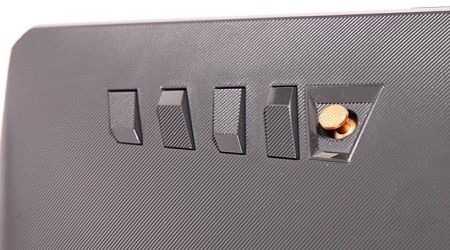
The Asus menu has evolved very well across the models, with a cleaner interface and neatly divided into sections for sub-menus. All the options are quite centralized and summarized, and we do not see, for example, as much variety as in some AORUS or MSI equipment. In this case, we do not have OSD software for Windows, although it is compatible with Armory Crate for lighting synchronization.
In the first section, all the Nvidia Reflex and ULMB content will appear well visible, while in the Gaming section, we will find the fundamental options for a player and the monitor’s performance. The third section of the image will have two important options: the variable backlight to automatically adapt to what is shown on the panel and the blue light filter.
This time the color profile is shown directly in the next section, being by default in SDR YCbCr. Here we miss a somewhat finer adjustment of the profiling since we have different predefined color temperature and gamma ranges. The rest of the sections are intended for basic configurations such as input or OSD position.
Final words and conclusion about the Asus ROG Swift 360 Hz PG259QNR
If this monitor makes something clear, it will not be for everyone, not only because of its 360 Hz refreshment, which is difficult to squeeze 100% but because of its high price. Never before has IPS technology delivered panels so blazingly fast to deliver 360 Hz and 1 ms of response.
But one of the novelties that stand out the most in it and that goes to the spot with the Nvidia Ampere cards will be Nvidia Reflex, to which we have devoted much of the analysis. The new processor that measures and improves the latency of the equipment works, offering important improvements for use in competition. Let’s be clear that this technology is focused on eSport; it makes little sense for campaign or solo gaming.
The greatest weight in the final experience is carried by its incredible refreshment, response, and input lag benefits. The tests that we do with testudo will give us a perfect result, although the clearest and most analyzable one will be ghosting, totally absent with the normal OverDrive mode. Image fluidity is the best seen on a monitor so far, being another key element that a professional gamer looks for.
Where we have been pleasantly surprised is in the image quality of the panel, with the IPS technology in color coverage, viewing angles, and above all, calibration being noticeable. Asus already proves to do a good job, including a calibration report, typically done on designer and non-gaming monitors. After verifying it with our colorimeter, we see a Delta E lower than 2. Whoever wants performance and image quality will have it assured.
The stand and design put the icing on the cake, with a very robust and oversized base for this panel of only 24.5 inches. It is used in all Swift models, increasingly polished, and its ergonomics are very good. The manufacturer has had the detail of including table support, to improve the rigidity and useful space on our desk.
The Asus ROG Swift, 360 Hz PG259QNR, is presented to us for reasonable price. Nothing cheap considering that it is a 24.5-inch Full HD panel, although as we say, the news is paid, and that is no exception. It remains to be seen how the competition has behaved with its 360 Hz versions and the price, but this Asus will be quite difficult to beat in quality and performance.
Advantage
- NVIDIA reflex real latency improvements.
- 360Hz and 1ms with an IPS panel.
- Perfect in blur and ghosting.
- Two base options and compatible with vesa.
- Very good calibration and coverage.
- The best for Esport.
Disadvantages
- The price, but it is normal since it is.
- The best gaming monitor for shooter of the moment.
Read Also: Best 4K Monitor for Programming.


